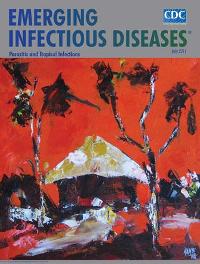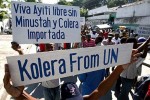Cholera for Sale In a Blue Plastic Bag: Infected Water Distributed in Haiti as Purified
By Dady Chery
Haiti Chery

Authorities are concerned that a number of those infected say they only drank supposedly treated water.
As of October 28, 2010, over 300 Haitian brothers and sisters have died, and more than 4,000 have fallen ill of cholera. The press immediately blamed poor sanitation in the camps for the cholera outbreak, although:
- Cholera had been absent from Haiti for more than 100 years. The impossibility of Vibrio cholera bacteria appearing from thin air made it patently clear that the disease came from a foreign source.
- The outbreak began, not in a crowded refugee camp in an earthquake-ravaged city, but in the pristine small towns of St. Marc and Mirebalais.
- Except for a minority of idiots or intransigents, as one is apt to find anywhere, residents of the afflicted towns had for years been boiling their drinking water or securing bottled water.
- A group of prisoners without access to rivers and streams came down with acute cases of the infection.
- Residents of l’Ile de la Gonave, an island well insulated from mainland Haiti by a body of sea water, came down with the disease.
Shitting downhill
Insistent reports that the focus of the disease is a Nepalese MINUSTAH base on a hill in Mirebalais led the Associated Press and Al Jazeera to dig deeper into this story. The reporters found brown, stinking, frothing human waste flowing from a septic tank behind the base and downhill into the Meille: a tributary of the Artibonite River. See the video below. The Artibonite is lined by a valley that serves as Haiti’s breadbasket.
The U.N. searches itself yet again
The U.N. got a good start on investigating itself yesterday by taking pic axes to the base’s septic tank right in front of the incredulous AP and Al Jazeera reporters. More recently, the U.N. looked into the suffocation of 16-year old Gerard Jean Gilles in August 2010 by personnel on a MINUSTAH Nepalese base. The U.N.’s response was to shield its soldiers with U.N. immunity. Despite Haitian protests demanding that MINUSTAH leave the country, the U.N. Security Council unanimously renewed MINUSTAH’s mandate on October 14, 2010.
Does Vibrio Cholerae O1 Ogawa Biotype El Tor sound Haitian to you?
The cholera in Haiti is the same type that caused an outbreak of infections in Nepal this summer. Though one could argue that these bacteria cannot absolutely be pinpointed to Nepal as their source, because the same infection has afflicted many other places, it is certain that O1 Ogawa biotype El Tor has never before seen Haiti. Nepalese or no, this cholera came from a foreign source.

Blue plastic bags of water of undefined origin, which are routinely distributed throughout Haiti (Photo: Bahare Khodabande, September 2015).
Blue Plastic Bags Labeled “Purified”
None of this explains why thousands of Haitians came down with acute cases of cholera after they had for years been on their guard about water-borne infections. Or why a group of prisoners came down with infections so severe that they died within hours. A dose of bacteria sufficiently high to kill a person within hours would most likely come from contaminated drinking water.
Now, on October 27, Al Jazeera reports that:
“Authorities are concerned that a number of those infected say they only drank supposedly treated water,”
and the director general of Haiti’s health department, Mr. Gabriel Thimote, warns that blue plastic bags of water, labeled purified, should not be trusted because they are filled with untreated Artibonite River water.
These blue bags of so-called purified water were being distributed by the truckload to the population. If you have one of these blue bags or any bottled water that you consider suspect:
- Don’t drink the water.
- Save the full bag or bottle.
We call on journalists and public health workers in Haiti to secure this possibly tainted drinking water and submit it for analysis to medical testing laboratories or microbiology laboratories independent of the the U.S. government or the U.N. If any bottled water in Haiti turns out to be contaminated with cholera, there will be a lot to answer for and hell to pay.
Cholera Cases on l’Ile de la Gonave
I am quite interested to know how residents of an offshore Haitian island became infected with cholera. Were the blue bags shipped to La Gonave? If so, who paid for these bags? Who sent them to La Gonave? How were they shipped there? Who distributed them? And of course, it goes without saying that I would like to know if MINUSTAH personnel lacking in toilet training were also shipped to La Gonave.

Water of undefined origin in a blue plastic bag being given to a poor child (Photo: Bahare Khodabande, September 2015).
An MSF Clinic Near a School
In regions where cholera is endemic, the continuing source of the cholera is usually the untreated waste effluent from hospitals and clinics. Therefore one can hardly blame the Haitian residents of St. Marc for being hopping mad at Medecins Sans Frontieres (MSF) for setting up a cholera clinic right next to a school in their town. It is a testament to Haitian self control that only stones were thrown at the clinic. Instead of listening to the townspeople’s concerns, MSF called in the police and a MINUSTAH Argentinian unit. Then MSF put out the following statement:
“we believe in these coming days we are going to start to work with this community, to explain to them that there is no risk for them to have such a facility to treat these patients inside.”
Now, who is the visitor here? An already fragile Haitian infrastructure is being overwhelmed by an influx of foreigners, most of whom are the soldiers of modern-day colonialist armies, like MINUSTAH, SouthCom, private mercenaries, and their softer arm of NGOs. There is a limit to Haitian graciousness. When you come to somebody’s home, you follow their rules. And, as one brother wrote about MINUSTAH, you sure as hell don’t take a dump in their living room. Else, you get kicked out.
Source: Haiti Chery
Video: UN Investigates Cholera Spread in Haiti







Comments
Cholera for Sale In a Blue Plastic Bag: Infected Water Distributed in Haiti as Purified — No Comments